|
|
|
Sort Order |
|
|
|
Items / Page
|
|
|
|
|
|
|
| Srl | Item |
| 1 |
ID:
192935
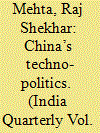

|
|
|
|
|
| Summary/Abstract |
The impact of China’s Digital Silk Road (DSR) on countries signing the Belt and Road Initiative (BRI) is a less explored area. This article argues that the repercussions of unregulated propagation of DSR on BRI countries are likely to go beyond economy and commerce because of the vastly different approach of China’s use of technology in its own governance. Since this aspect is inadequately covered in existing literature, an attempt is made to fill the gap. When external entities are allowed to setup large-scale digital networks, e-governance and e-commerce in technologically deficient countries of the Global South, the host country loses control over its digital data that such networks generate. Overdependence on technology of one nation can lead to a data monopoly with a potential impact on the entire polity. To what extent this hypothesis holds substance is the issue deliberated on in this article using inductive reasoning and qualitative methods.
|
|
|
|
|
|
|
|
|
|
|
|
|
|
|
|
| 2 |
ID:
192937
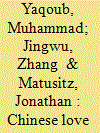

|
|
|
|
|
| Summary/Abstract |
This cross-sectional study examines the acceptance of Indian cinema among Chinese cinephiles to determine how the audience perceives and is influenced after watching Indian films. Researchers surveyed the local Chinese audience and collected 2,129 valid self-structured e-questionnaires. Respondents belonged to Mainland China. Results showed significant characteristics that make Indian movies attractive to about 50% of the Chinese population. Findings also indicate that Chinese people still welcome good stories from India in blockbuster Bollywood films, despite tense Sino-Indian relations. Indian cinema plays a significant role as a soft power bridging both nations. The Indian film industry will continue to evolve to satisfy the audience’s needs in the future.
|
|
|
|
|
|
|
|
|
|
|
|
|
|
|
|
| 3 |
ID:
192936


|
|
|
|
|
| Summary/Abstract |
The two nuclear-armed states of South Asia, India and Pakistan, besides being arch-rivals face common non-traditional security challenges. A recent example indicates that, despite having differences, they cooperated to successfully deal with the locust upsurge of 2019–2020. This study looks at why and how they arrived at joint efforts to thwart this non-traditional security threat. To set the context for this, it also explores the phases of the locust cycle and the reason why it constitutes a potential threat to the food security of both India and Pakistan. The study finds that the chances of cooperation between hostile states may increase if there are mutual threats in the non-traditional security realm. It further concludes that the chances of cooperation between the belligerent states increase if they are part of regional and international mechanisms to deal with the threats.
|
|
|
|
|
|
|
|
|
|
|
|
|
|
|
|
| 4 |
ID:
192934


|
|
|
|
|
| Summary/Abstract |
China’s relationship with the African continent has faced extensive critique over the past few decades, with most explanations broadly falling under the umbrella of three metanarratives: a ‘developing partner’, an ‘economic competitor’ or a ‘hegemonic actor’.1 Although these labels help to make intelligible the broad intentions of China’s interaction on the continent, they unwittingly gloss over the importance of choice and agency that the African nations continue to hold in deciding their future trajectories. Essentially, deconstructing these narratives to uncover the principal characteristics of China’s approach to the African continent is the central puzzle of this study. The study further questions the extent to which the agency of African nations determines their relationship with China. This article essentially proposes that while each of the three descriptions provides an insight into the various facets of the Sino-African relationship, none of them captures the whole picture, and instead, China’s approach to the African continent is best understood by its pragmatism, which is guided by its political aspirations and economic objectives. Furthermore, the study argues that the agency of each African nation also plays a part in shaping how China’s pragmatic approach further translates into one of the three metanarratives. The article relies on an inductive exploration of its central research question and uses a variety of sources, which include data from international institutions and governments, government releases and secondary literature, amongst others.
|
|
|
|
|
|
|
|
|
|
|
|
|
|
|
|
| 5 |
ID:
192933
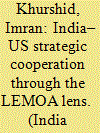

|
|
|
|
|
| Summary/Abstract |
Since Narendra Modi took office, India and the United States’ strategic ties have become stronger. It took almost 12 years to sign the ‘Logistics Exchange Memorandum of Agreement (LEMOA)’. The LEMOA offers a framework for governing the logistical assistance, supplies and services exchanged between the Indian and US forces on a reciprocal and reimbursable basis. Concerns in India’s strategic elite and political class over the endangerment of India’s strategic autonomy and compromising India’s sovereignty for a long time prevented the execution of this agreement. However, after the BJP government came to power in 2014, it negotiated this agreement with the United States. India has strategically moved closer to the United States by signing this agreement, which will have a lot of positive effects on the development of India’s strategic capabilities and the strengthening of Indian defence forces’ operational capabilities. It will also allow India to expand its strategic influence in the Indo-Pacific region. This study analyses the LEMOA, its implications for India’s strategic autonomy, and its subsequent implications for expanding India’s strategic footprint in the region.
|
|
|
|
|
|
|
|
|
|
|
|
|
|
|
|
| 6 |
ID:
192938
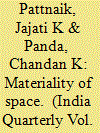

|
|
|
|
|
| Summary/Abstract |
The materiality of space refers to the material constituents determining the space. The spatial imagination of the borderland, characterised by critical spatiality, is materially constituted. The fact of being materially constituted means to be infrastructurally configured. The infrastructures here include hydro projects, highways, railroads, bridges, tunnels, airports, digital connectivity and other defence-related installations. These projects combine a two-pronged approach: security and development. The security challenges that the border space embodies compel the state to adopt an approach of competitive infrastructure building. The nature of this competition is determined by the competing other’s approach towards the border space. Arunachal Pradesh is a very critical border state that shares its crucial border space of 1,080 km with China, 160 km with Bhutan and 440 km with Myanmar. China’s increasing geopolitical clout in the region intensifies its spatial and material prominence. India under its Act East Policy (AEP) formulation in 2014 has taken up a very determined approach to accelerating infrastructure growth in the northeast and more particularly in Arunachal Pradesh for its border spatiality. Therefore, the border space loses its inferential, conjectural and abstract character and becomes materially determined. This imperative for materiality embodies, on the one hand, development, modernity, capitalist social space and mainstreaming of the neglected and, on the other hand, protectionism and upgradation of security architecture along critical geography known as the border space. Therefore, this study examines the development of materiality, meaning infrastructure, in a complex border space like Arunachal Pradesh. It decodes the economic logic of the systematic development of border space by the Indian nation-state from the point of view of the growth of the region and security urgency. It uses Henri Lefebvre’s theoretical formulations of spatiality to understand the convoluted category of border space and the introduction of material forces to achieve security and developmental objectives.
|
|
|
|
|
|
|
|
|
|
|
|
|
|
|
|
| 7 |
ID:
192932
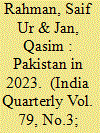

|
|
|
|
|
| Summary/Abstract |
Pakistan continues to face multiple sources of internal and external conflicts. Its all-powerful military is engaged in a subterranean battle to maintain its power. Economically, the country persisted in troubled waters as it has been for most of its recent history. In domestic politics, the failed experiment of a hybrid regime under Ex-Prime Minister Imran Khan forced the military to part ways with Mr Khan and install a coalition government of 13 political parties through a no-confidence vote in parliament in April 2022. Mr Khan’s political party is facing a severe crackdown in Pakistan after he accused the powerful military of his ouster from power. At the regional level, a favourable outcome in Afghanistan in the shape of the Taliban’s takeover has not yielded any significant positive results for Pakistan. After concluding the Afghan conflict on a favourable note, paradoxically, the military establishment hints at a desire to shift away from geo-security to geo-economics in its foreign policy goals. At the extra-regional level, the military is walking a tightrope to balance its ties between the USA and China to offset any adverse consequences arising from its strategic partnerships with China over China–Pakistan Economic Corridor (CPEC). In this article, we explain a series of issues confronting Pakistan currently—including a deep economic crisis, political paralysis, and a resurgent terror threat—focusing on the military’s ambitions in the region and beyond.
|
|
|
|
|
|
|
|
|
|
|
|
|
|
|
|
| 8 |
ID:
192939


|
|
|
|
|
| Summary/Abstract |
Seventy-six years after its establishment, the United Nations (UN) today stands at a critical juncture where it must undertake radical reforms to remain relevant in the changing face of the twenty-first century. Such reforms are essential to prevent the UN from becoming redundant and being pushed to the sidelines of great power politics in the emerging multipolar world. While there has been much political clamour among the international community calling for the restructuring of the UN Security Council, which is also in the interest of India, an appraisal of the UN’s military capability to intervene in Contemporary Armed Conflicts under Chapter VII of its Charter needs to be assessed. The absence of a standing reserve and the procedural complexities involved in deriving the manpower for peacekeeping operations from the member states have undermined the UN’s capability to swiftly intervene in an escalating armed conflict even after getting approval from the Security Council. At present, a plethora of factors have resulted in the increasing volatility of contemporary armed conflicts. Under these circumstances, the UN’s capacity for swift intervention after the outbreak of a conflict has become even more relevant today than in the past. The creation of a UN Vanguard Brigade based on the recommendations given by the 2015 High-Level Independent Panel on Peace Operations is a major step in that direction. Using a case analysis of the Rwandan genocide, this article critically examines the challenges of the vanguard brigade to optimise the UN’s capability for rapid deployment of peacekeepers for swift intervention in an escalating Armed Conflict. The article is largely descriptive and analytical, using predominantly secondary sources and UN documents.
|
|
|
|
|
|
|
|
|
|
|
|
|
|
|
|
|
|
|
|
|